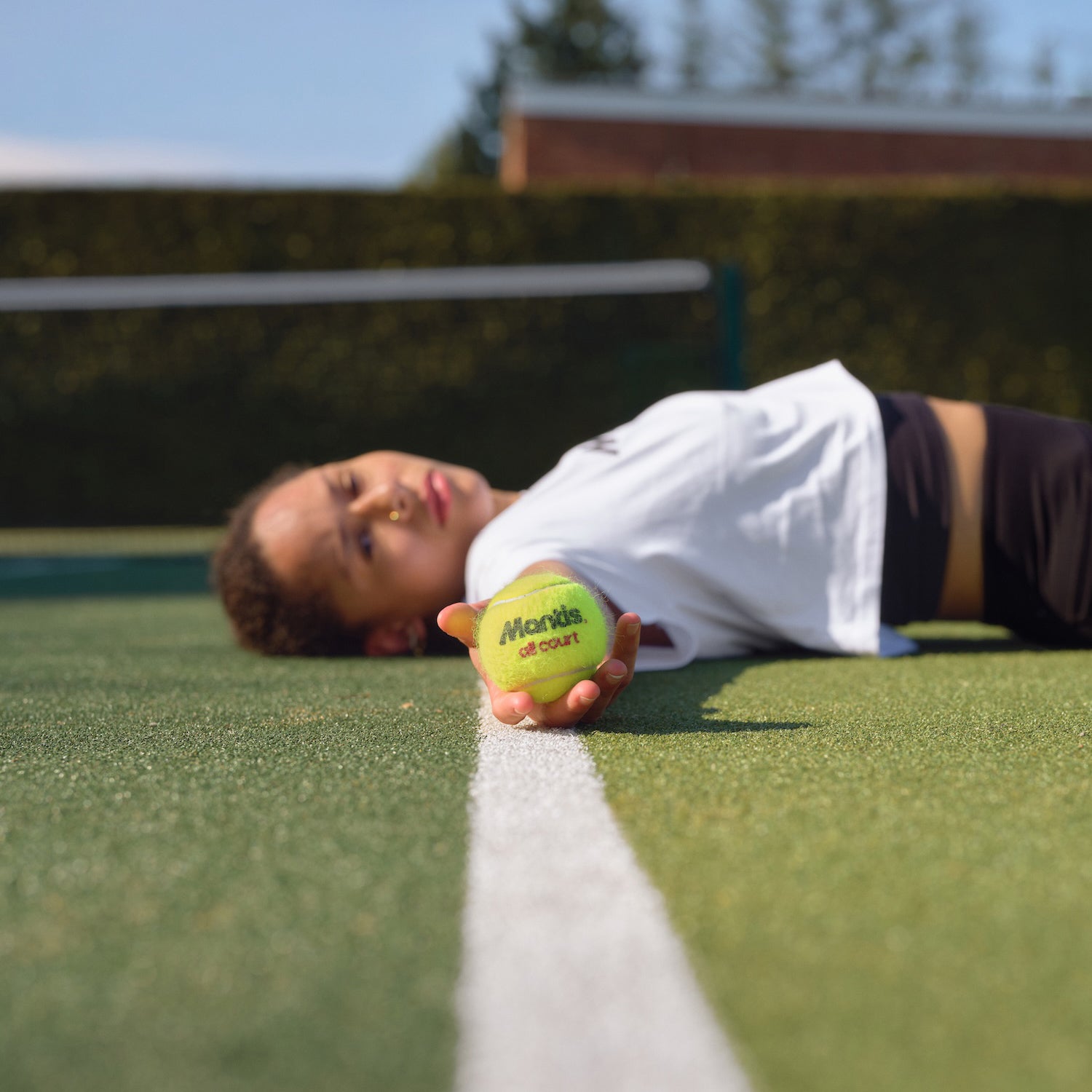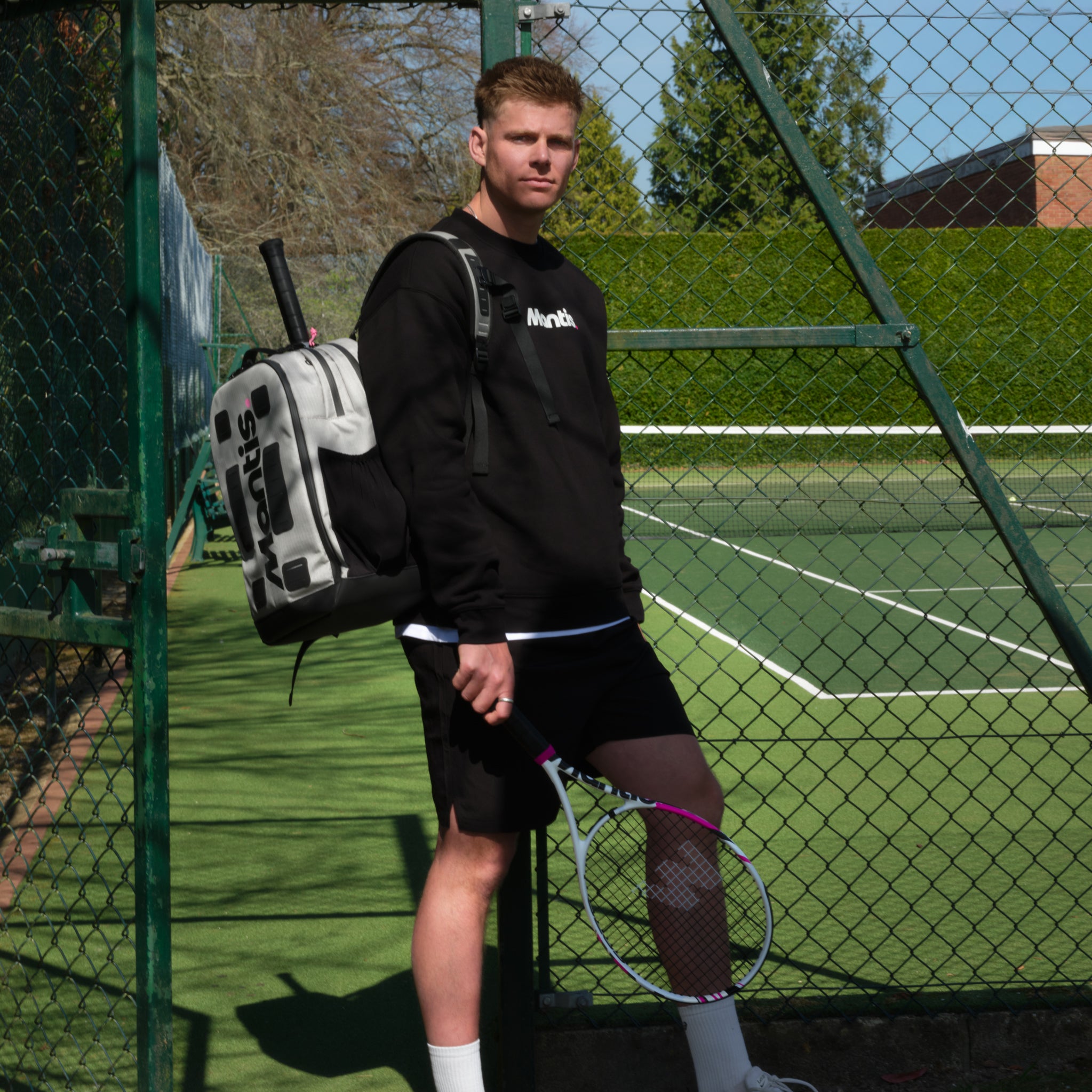
That sharp, nagging pain on the outside of your elbow isn't just an annoyance; it's your body telling you that the tendons are seriously overworked. Getting back on track means figuring out what's causing the strain and then jumping into some targeted tennis elbow exercises to rebuild your strength and flexibility. By starting with gentle movements, you can get the pain under control and kick-start the healing process. Here at Mantis, we know a solid recovery plan is built on good information. For some extra insight on prevention, we highly recommend reading our guide on selecting the correct grip size for your racket.
Understanding tennis elbow
We see it all the time—elbow pain can sideline players and professionals, keeping them from the activities they love. The condition, officially known as lateral epicondylitis, is often misunderstood. It’s not just a problem for tennis players; it's a repetitive strain injury that can affect anyone who repeatedly uses their forearm muscles.
The discomfort actually comes from the tendons connecting your forearm muscles to that bony bump on the outside of your elbow. When you constantly grip, twist, or lift, these tendons can develop tiny tears, which leads to inflammation and that all-too-familiar pain.
What Causes the Strain?
Imagine your forearm tendons are like a rope that starts to fray from constant use. Any activity that makes you bend your wrist backward again and again (known as wrist extension) can set this off. This includes plenty of common tasks you might not even connect with elbow pain at first.
This repetitive stress is the number one culprit behind the inflammation. It’s an overuse injury, plain and simple.
Common triggers often include:
- Racket Sports: A poor backhand technique or using a racket that’s too heavy can easily overload those extensor tendons.
- Manual Trades: Plumbers, carpenters, and painters who are always using tools like screwdrivers or hammers are at a much higher risk.
- Office Work: Believe it or not, hours of typing and using a mouse can put a chronic strain on the very same forearm muscles.
- Hobbies: Even things like playing the violin, knitting, or a long afternoon of gardening can contribute to the problem.
Getting to the root cause of your pain is the absolute first step towards a real, long-term recovery. It’s not about giving up what you love, but learning how to do it in a way that doesn’t cause more harm.
Recognising the Symptoms
The signs of tennis elbow usually start as a mild ache but can get much worse if you ignore them. You might only notice the pain during certain activities at first. Before you know it, though, it can turn into a constant, dull ache or even a sharp, burning sensation. For a deeper dive into how equipment choices can impact your game and your body, many players find resources like those on racketbusiness.com to be a great help.
Here are the key symptoms to look out for:
- A persistent pain or burning on the outer part of your elbow.
- A noticeably weak grip, making it tough to do simple things like hold a coffee cup or turn a doorknob.
- Pain that shoots down your forearm towards your wrist.
- More discomfort when you lift something, make a fist, or shake hands.
This pain is a clear signal from your body that the tendons are inflamed and desperately need a break to rehabilitate. Pushing through these early signs can lead to a more chronic condition that’s far more difficult to treat.
The exercises we're about to explore are designed to tackle these symptoms at their source, helping to promote healing and rebuild the resilience of those affected tendons. By understanding what’s really going on inside your arm, you're in a much better position to start your recovery on the right foot.
How tennis elbow exercises can help
The last thing you probably want to do when your elbow is aching is exercise it. We get it. It seems completely backwards to use movement to fix an injury that was caused by too much movement in the first place. But a carefully structured exercise programme is exactly what your elbow needs to heal properly.
Here at Mantis, we've seen countless players recover from tennis elbow, and the key is always a combination of smart rest and targeted movement. The science behind using tennis elbow and exercises is all about applying controlled, specific stress to the damaged tendons. This doesn't just soothe the symptoms; it actively repairs and strengthens the area for the long haul.
The nagging pain you're feeling comes from tiny micro-tears in a specific tendon, the extensor carpi radialis brevis (ECRB). A good exercise plan works to rebuild this damaged tissue from the inside out, making it more resilient than before. For a deeper dive into building that foundational strength, check out our insights on tennis strength training.
The Method Behind the Movements
Think of your recovery as a journey with a few distinct phases. You don't just jump into heavy lifting.
First, the goal is simply to calm things down and improve flexibility. Once the pain starts to subside, you can shift your focus to rebuilding the strength and integrity of those tendon fibres. This gradual progression is absolutely crucial to avoid stirring up the injury again.
Each type of exercise has a very specific job to do:
- Gentle Stretches: These are your first port of call. Their job is to release the constant tension in your forearm muscles, which takes the pressure off that irritated ECRB tendon. This can bring immediate relief and creates a much better environment for healing to begin.
- Isometric Holds: Next up are isometrics. This is where you tense the muscle without actually moving your wrist or elbow. They're perfect for the early stages because they gently wake up the muscles and get blood flowing to the tendon, all without causing any painful joint movement.
- Eccentric Exercises: This is where the real rebuilding happens. Eccentric movements focus on lengthening the muscle while it's under tension. This specific action is what signals your body to produce new collagen and reorganise the tendon fibres, making them stronger and neatly aligned.
The point of these exercises isn't to grit your teeth and push through the pain. It’s about methodically and patiently rebuilding the tendon's ability to handle load. By applying controlled stress, you’re encouraging the body to lay down new, stronger tissue, effectively armour-plating the area against future problems.
Why Physio-Led Exercise is Now the Go-To Approach
In the UK, how we treat tennis elbow has changed a lot. We've moved away from passive treatments and now heavily favour active recovery. With an incidence rate of about 2.45 cases per 1,000 person-years, it’s a common issue. While most people get better, around 10% of individuals are still dealing with symptoms more than a year later.
There's also a growing caution around corticosteroid injections. They might give you a short-term fix, but the evidence suggests they can actually weaken the tendon in the long run. The focus now, backed by clinical guidelines, is squarely on physiotherapy-led exercise plans that put you in control of your own healing.
Remodelling and Strengthening Your Tendons for Good
The most critical part of this whole process is the remodelling phase, and eccentric exercises are the star of the show.
Picture the damaged fibres in your tendon as a tangled mess of string. Eccentric movements work to gently untangle and align those strings, making the whole structure tough and resilient again.
A classic example is slowly lowering a light dumbbell after lifting it with your good hand. That controlled lowering action puts a specific lengthening force on the tendon, which has been proven to kick-start the production of new collagen—the very protein that builds your tendons.
Of course, this doesn't happen overnight. It takes consistency and a bit of patience. But the strength you build through these targeted tennis elbow and exercises isn't just for recovery; it's your best defence against it happening again. A strong, resilient tendon is far less likely to get re-injured, whether you’re on the court, in the garden, or typing at your desk.
Ultimately, by committing to a proper exercise plan, you’re taking charge. You aren't just waiting for the pain to fade; you are actively rebuilding your arm to be stronger and more robust than it was before.
Gentle Stretches for Immediate Relief
When you're dealing with a nasty flare-up of tennis elbow, the first thing you want is relief. That sharp, nagging pain needs to be calmed down, and that's where gentle stretching comes in. It’s one of the best first-line defences because it works almost immediately to ease the tension that’s built up in your overworked forearm muscles.
The whole idea is to carefully lengthen the wrist extensor and flexor muscles—the ones directly linked to those inflamed tendons at your elbow. You're aiming for a gentle, sustained pull that allows the muscle fibres to relax. This not only feels good but also helps increase blood flow to the area, which is exactly what you need to kickstart the healing process.
This infographic lays out the simple, three-phase journey to recovery, and it all begins right here with stretching.

As you can see, stretching is the foundation. It prepares your arm for the next steps: strengthening and, eventually, remodelling the tendon so it's resilient for the long haul.
To get started, here's a quick summary of the key stretches you'll be doing in this initial phase.
Phase 1 Recovery Stretches for Tennis Elbow
This table outlines the foundational stretches designed for immediate pain management and to gently improve your flexibility. The key is to be consistent and listen to your body.
| Stretch Name | Primary Purpose | How to Perform | Recommended Hold & Reps |
|---|---|---|---|
| Wrist Extensor Stretch | Targets the top forearm muscles to relieve pain. | Extend your arm with your palm down. Let your wrist hang, then use your other hand to gently pull your hand towards your body. | Hold for 15-30 seconds, repeat 2-3 times. |
| Wrist Flexor Stretch | Balances muscle tension by stretching the inner forearm. | Extend your arm with your palm up. Bend your wrist down, then use your other hand to carefully pull your fingers back toward your body. | Hold for 15-30 seconds, repeat 2-3 times. |
Performing these stretches correctly is more important than how hard you push. Let's break down the technique.
The Foundational Wrist Extensor Stretch
This is your go-to stretch for tennis elbow. It directly targets the extensor muscles on the top of your forearm, which are almost always the main culprits. Getting this one right is crucial for relief without causing more problems.
Start by holding your affected arm straight out in front of you, with your palm facing the floor. Now, simply let your wrist and hand drop down, so your fingers are pointing towards the ground.
Using your other hand, apply very gentle pressure to the back of the hanging hand, pulling it slightly in towards your body. You should feel a mild to moderate stretch along the top of your forearm. Hold it right there for 15 to 30 seconds.
Remember, no bouncing! This needs to be a static, comfortable stretch. Repeat this 2-3 times, with a little rest in between each one. You can do this several times a day, especially when taking a break from whatever activity is aggravating your arm.
Our best advice here is to be gentle. The goal isn't a deep, painful pull. It's a sustained, comfortable release. If you push too hard, you risk irritating the tendon even more. Listen to your body—if you feel any sharp pain, back off immediately.
Balancing with the Wrist Flexor Stretch
While the extensor muscles get all the attention, it’s important not to forget their counterparts on the underside of your forearm—the flexors. Stretching these helps create balance and maintain flexibility across the entire joint, which is vital for proper function.
The setup is similar: extend your arm straight out, but this time, have your palm facing up.
Gently let your wrist bend downwards, with your fingers pointing to the floor. With your other hand, carefully pull your fingers back towards you. You'll feel this stretch along the inside of your forearm. Just like before, hold it for 15 to 30 seconds without any bouncing.
Aim for 2-3 repetitions. By doing both the extensor and flexor stretches, you're looking after the whole system that controls your wrist and elbow.
When and How to Perform These Stretches
Timing and technique are everything. These stretches are far more effective when your muscles are warm, so trying to do them first thing in the morning when you're stiff isn't the best idea.
Here are a few practical tips to work these into your day:
- Warm up first. Do them after a short walk or after applying a warm compress to your elbow for a few minutes.
- Take work breaks. If you’re at a desk all day, set a reminder to stretch every hour. Repetitive strain from typing is a common trigger, and simple movements can make a huge difference.
- Never stretch cold. Stretching cold muscles is a recipe for a strain. A little bit of light activity beforehand goes a long way.
By consistently performing these gentle tennis elbow and exercises, you’ll be able to manage that initial pain and lay the groundwork for the strengthening that comes next. This first step is all about getting relief and preparing your arm for a full recovery.
Building Strength for Long-Term Prevention
Once the initial sting from stretching starts to fade, the real work begins. This is where we focus on preventing tennis elbow from ever coming back. Building strength is the absolute cornerstone of a lasting recovery, and it's a phase we guide players through carefully. You’re essentially shifting from just managing pain to actively armour-plating your arm against future strain.
For a broader look at overall conditioning, our detailed guide on tennis strength training is a great resource.
The strengthening journey has to start gently. You can't just jump into heavy weights; that’s a surefire way to re-aggravate the sensitive ECRB tendon. Instead, think of it as a gradual process, moving from simple muscle activations to more demanding exercises that actually remodel the tendon fibres.
This slow and steady approach gives the tendon time to adapt and grow stronger without being overloaded. You’re laying a solid foundation before building the rest of the house.
Starting with Isometric Exercises
Isometric exercises are the perfect place to start when your elbow is still feeling tender. Their big advantage is that they let you contract your forearm muscles without any movement at the wrist or elbow joint. This is brilliant because it wakes up the muscles and gets blood flowing to the area to promote healing, all without causing painful friction on the tendon itself.
A really simple but effective one is the towel grip.
- Find a comfortable seated position and rest your forearm on a table or your thigh.
- Grip a rolled-up towel or even a soft stress ball in your hand.
- Gently squeeze it and hold that contraction for 5-10 seconds.
- Slowly release your grip.
- Aim to repeat this 10-15 times, but make sure you never squeeze to the point of pain.
This subtle muscle activation starts reinforcing the muscle-tendon connection, getting your arm ready for the more dynamic exercises that come next. You’re building a base level of strength without risking a setback.
Progressing to Eccentric Strengthening
When you can get through those isometric exercises without any discomfort, it’s time to bring in eccentric movements. This is arguably the most critical type of exercise for healing tendinopathies like tennis elbow. Eccentric work focuses on lengthening a muscle while it’s under tension. It's this specific action that stimulates collagen production and helps realign the tendon fibres, making them stronger and better organised.
The real magic of eccentric training is in that controlled lengthening of the muscle. This specific stress signals the body to repair and remodel the tendon, transforming weak, jumbled tissue into a strong, resilient structure that can handle the demands of your sport.
One of the best-known eccentric exercises for tennis elbow is the Tyler Twist, which uses a simple bit of kit called a FlexBar.
Here's how you do it:
- Hold the FlexBar vertically in front of you with the hand of your injured arm.
- Grasp the top of the bar with your other hand, palm facing away from you.
- Twist the bar with your top (uninjured) hand, keeping your bottom wrist straight.
- Extend both arms straight out in front of you, maintaining the twist in the bar.
- Slowly and with full control, untwist the bar by letting the wrist of your injured arm extend.
That controlled untwisting motion is the eccentric part you’re after. Aim for 3 sets of 10-15 repetitions daily.
Incorporating Light Weights and Resistance Bands
As your arm gets stronger, you can start to add light weights or resistance bands into your routine. These tools are great because they allow you to track your progression more easily. The key is to start very light and concentrate completely on perfect form.
Eccentric Wrist Extension with a Dumbbell
This is a classic for a reason – it works.
- Sit down and rest your forearm on a flat surface (a table or your thigh works well), with your hand hanging off the edge, palm facing down.
- Hold a light dumbbell – start with just 0.5kg or 1kg.
- Use your good hand to lift the weight up, extending your wrist for it.
- Now, let go with the supporting hand and slowly lower the weight back down over a count of four or five seconds.
- All the focus is on this slow, controlled lowering phase. Repeat for 3 sets of 15 reps.
Banded Wrist Extension
Resistance bands offer a slightly different kind of resistance and are perfect for when you're travelling.
- Sit down and loop a light resistance band under your foot.
- Hold the other end of the band with the hand of your affected arm.
- Rest your forearm on your thigh, palm down, with your wrist just over your knee.
- Slowly extend your wrist upwards against the band's pull.
- Hold it for a second at the top, then slowly return to the start.
Concentrate on smooth, controlled movements for 3 sets of 15 repetitions. These targeted exercises are designed not just to heal your current injury, but to build a level of forearm strength that massively reduces the risk of it ever coming back. In this phase, consistency is your best friend.
Weaving Recovery into Your Everyday Life
A dedicated set of exercises for tennis elbow is a fantastic start, but here at Mantis, we've seen time and again that real, lasting recovery comes from weaving smart habits into your day-to-day. It’s not just about that 20-minute routine; it’s about making small, conscious adjustments that protect your elbow from future strain, whether you're typing at your desk or stepping back onto the court.
This is where the magic really happens—looking beyond the specific exercises to how you can apply recovery principles all day long. For a deeper dive into preventive measures, our guide on how to prevent tennis elbow is packed with extra insights. Consistently making these small changes can dramatically lighten the load on your healing tendons.
Rethinking Your Daily Ergonomics
It's a common misconception that tennis elbow only comes from sport. In reality, many cases are made worse by the simple, repetitive tasks we do every day. A few thoughtful modifications to your environment can make a world of difference in reducing that constant, low-level stress on your forearm.
Your workspace is often ground zero. If you spend hours at a computer, take a moment to optimise your setup:
- Your Chair: Adjust its height so your feet rest flat on the floor. Your forearms should be roughly parallel to the ground when you type, not angled up or down.
- Keyboard & Mouse: The goal is to keep your wrists in a neutral, straight line. Stop them from bending upwards. Many people find that ergonomic keyboards or a vertical mouse are game-changers for maintaining this alignment.
- Take a Break: It sounds simple, but it’s vital. Set a timer to remind yourself to stand up, stretch your wrists, and move about for a few minutes every hour.
This mindset extends beyond the desk. Think about how you lift and carry things. Whenever you can, lift with your palms facing up. This simple switch engages your bicep muscle instead of the much smaller, and currently overworked, forearm extensors. When carrying groceries or a gym bag, try to distribute the weight evenly and keep your elbows slightly bent to avoid locking the joint under load.
Making a Smart Return to Your Sport
For any athlete, the urge to jump straight back into the game is powerful, but rushing it can unravel all your hard work. A slow, steady, and phased approach isn't just a suggestion—it's non-negotiable. Your elbow needs time to re-adapt to the very specific demands of your sport.
Before you even think about playing a full match, put your technique under the microscope. A sloppy backhand is one of the biggest culprits behind tennis elbow. It might be worth working with a coach to analyse and refine your stroke, making sure you’re generating power from your core and shoulder, not just your arm.
A safe return to play isn’t a race. It’s a carefully managed process of reintroducing stress to the tendon. Listen to your body—any sharp pain is a clear signal to stop, reassess, and perhaps take a step back.
Your warm-up routine is now more important than ever. Dedicate at least 10-15 minutes to dynamic stretches and some light cardio to get your blood flowing properly before you start hitting. Afterwards, make time for a cool-down, using the same gentle wrist extensor and flexor stretches from your initial recovery phase.
A Real-World Recovery Story
Let's picture a typical club player—we’ll call him David. He has an office job and loves to play tennis twice a week. After developing a nagging case of tennis elbow, his recovery plan wasn't just about what he did on the court, but how he integrated smarter habits into his entire week.
At Work: David set hourly reminders on his phone to get up and do his wrist stretches. He also invested in an ergonomic mouse that kept his wrist straight, which massively reduced the strain during his workday.
Daily Tasks: He became much more mindful of how he lifted things. He’d consciously turn his palms up to carry his laptop bag or a box, shifting the load away from his forearm extensors.
Return to Tennis:
- Weeks 1-2: He began with just 15 minutes of light rallying, focusing entirely on a clean, technically sound backhand. He completely avoided serves and smashes.
- Weeks 3-4: David upped his court time to 30 minutes and started reintroducing serves, but only at 50% intensity. No cannons yet.
- Weeks 5-6: He finally started playing short practice sets, paying very close attention to any hint of discomfort. As a precaution, he iced his elbow for 15 minutes after every single session.
By blending ergonomic adjustments with a patient on-court strategy, David didn't just recover—he built more resilient, protective habits. This kind of holistic approach is what makes recovery stick, turning a short-term fix into long-term prevention.
Common Questions About Tennis Elbow Recovery
When you're trying to recover from tennis elbow, it’s natural to have a lot of questions. We get it. Understanding the process is key to feeling confident in your recovery plan, so let's clear up a few of the most common queries we hear.
If you're also looking for ways to stop it from coming back, our guide on how to prevent tennis elbow has some great additional tips.
How Long Does It Really Take to Feel Better?
This is usually the first thing people ask. With a consistent daily routine of the right stretches and exercises, you should start to feel a genuine improvement within two to four weeks. You might notice less pain during everyday tasks or a bit more strength when you grip things.
But it’s important to remember that feeling better isn't the same as being fully healed. Building back the tendon’s resilience takes time, often several months. Patience truly is your best friend here.
Can I Keep Playing Tennis While I Recover?
In the early stages, when the pain is sharp and constant, you absolutely have to rest the arm. Pushing through the pain will only make things worse and set your recovery back.
Once the initial pain starts to fade and you feel your strength returning, you can think about a gentle return to the court. The key word is gradual. Start slow, pay close attention to how your arm feels, and stop immediately if you feel any sharp pain.
What Gear Can Help My Exercises?
While you can do a lot with just your own body weight, a few simple tools can make your exercises much more effective and help you target the muscles more precisely.
Here’s what we find works best:
- Resistance Bands: Incredibly versatile for gentle strengthening. A light band is perfect for those initial wrist extension exercises.
- Light Dumbbells: Ideal for controlled eccentric movements. Don't be a hero—start with something as light as 0.5kg.
- Therapeutic Bars (like a FlexBar): These are purpose-built for recovery. They’re brilliant for exercises like the Tyler Twist, which is one of the most effective for helping the tendon to remodel itself.
When Is It Time to See a Doctor?
A good exercise programme can work wonders, but there are definitely times when you need to bring in a professional. Don't hesitate to book an appointment with a doctor or a physiotherapist if you notice any red flags.
You should seek a professional medical opinion straight away if the pain is severe, if it doesn't get any better after a few weeks of consistent exercises, or if you start to lose sensation in your hand or fingers. It’s crucial to rule out anything more serious.
At Mantis, we know that the right equipment is a massive part of your journey, whether you're recovering from an injury or playing at your peak. Check out our range of expertly crafted tennis rackets, balls, and accessories—all designed for players who are passionate about the game. Find your perfect gear at https://mantissport.com.










